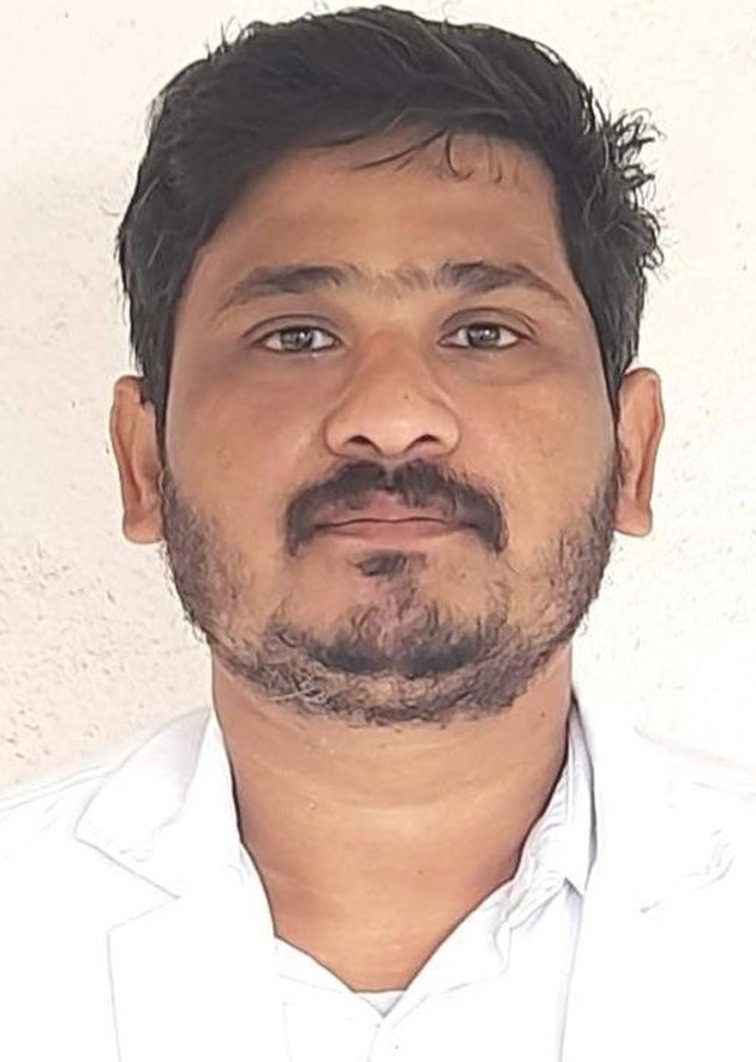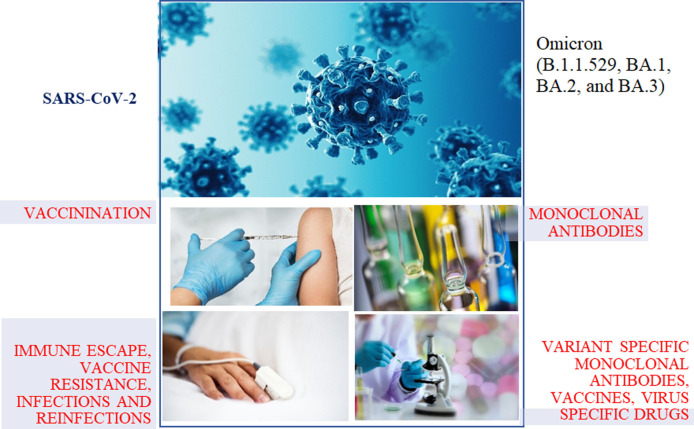Abstract
The SARS‐CoV‐2 virus has shown increased ability to mutate over the past two years, especially in the regions of the spike protein and receptor binding sites. Omicron (B.1.1.529) is the fifth variant of concern (VOC) after the emergence of the Alpha, Beta, Gamma, and Delta VOCs of SARS‐CoV‐2. This new variant has now circulated in 128 countries and according to the Global Initiative on Sharing All Influenza Data (GISAID), these 128 countries have shared 650,657 Omicron genome sequences as of 26 January, 2022. In this article, we highlight the real challenges of Omicron and its different lineages.
Keywords: SARS-CoV-2 VOC, Omicron lineages, BA.1, BA.2, BA.3
SARS‐CoV‐2 is continuously mutating and is regularly re‐emerging. The recently emerged Omicron variant shows high rates of mutation at the spike protein and receptor binding domain regions. Because of these mutations, the Omicron variant has been noted to have the highest transmissibility among the previous SARS‐CoV‐2 variants including the Delta variant. Given Omicron's high genetic variability, it demonstrates immune escape mechanisms that potentially negate vaccine protection and causes re‐infections. Therefore, variant‐specific monoclonal antibodies, drugs, and vaccines are required to counter the pandemic.
After the emergence of SARS‐CoV‐2, since last two years it has shown increased ability to mutate, especially in the regions of spike protein and receptor binding sites. [1] Omicron (B.1.1.529) is the fifth variant of concern (VOC) after the emergence of other four VOCs of SARS‐CoV‐2 (Alpha, Beta, Gamma, and Delta).[ 2 , 3 ] This new variant now circulated in 128 countries and as per GISAID, these 128 countries have shared 650,657 Omicron genome sequences as of 26 January 2022. [4] On the basis of mutations, the Omicron variant is classified into four lineages (B.1.1.529, BA.1, BA.2, and BA.3) and the differences are also explored.[ 5 , 6 ] As per a recent study, there are no specific mutations observed for the BA.3 lineage in spike protein. However, it is a combination of mutations in BA.2 and BA.1 S‐proteins. [7] As these lineages are developed simultaneously and probably from the same place (Botswana, South Africa), so they may have equal chances of spreading worldwide however, the rate of spread may be different. Now, BA.1 is becoming the dominant lineage and spreading faster than BA.2. It is also observed that the BA.3 lineage spread slowly and causing very fewer cases which may be due to the loss of six mutations. As reported, the S‐protein of BA.1 contains 37 mutations, BA.2 contains 31 mutations, whereas BA.3 contains 33 mutations. [7]
The sub‐variant “BA.2” has emerged recently in the UK. Now this sub‐variant is identified in Denmark, Sweden, Norway, and India. According to WHO, this variant is now reported from 40 countries and now spreading worldwide rapidly. It is known that Omicron (BA.1) has high transmissibility and infectivity compared to the Delta variant, but the hospitalization rates are lower and it has a less severe disease progression. However, the new sub‐variant (BA.2) may have high severity. Several countries have observed these subvariants with strikingly different genetic characteristics. Out of these, BA.2 became dominant in many countries and has rapidly replaced other subvariants may be due to the presence of specific mutation (H78Y). [8] In this context, Lyngse and co‐workers have estimated the transmission dynamics of BA.1 and BA.2 among 8,541 primary household cases based on the nationwide Danish data. [9] As per the study, BA.2 is substantially more transmissible as compared to BA.1 and also possesses an immune‐evasive property which further reduces the protective effect of vaccination. Moreover, the secondary attack rate in households is estimated to be more for BA.2 (39 %) as compared to BA.1 (29 %). Another most important matter of concern is this new sub‐variant (BA.2) is not identified by RT PCR test. In this context, it is highly recommended to update the assays for variant‐specific PCRs in the spike gene of SARS‐CoV‐2 to readily detect and diagnose such emerging VoCs. [10] A multiplex RT‐qPCR assay specific to Omicron lineage has been developed recently to detect and differentiate the Omicron subvariants (BA.1, BA.2/BA.3). [11] In addition, the Omicron variant is mainly making severity (oxygen and ventilator requirements) to people of age higher than 70 and the person having comorbidities such as diabetes, blood pressure, cardiac and neurological issues. The symptoms are non‐specific as compared to other variants and the symptoms are differently observed in younger and elders. In case of elders, this Omicron variant causes neuromuscular issues as their muscles are weaker as compared to youngers. As per WHO, Omicron is not mild and may cause severity with the progress of the disease. Now, the USA reported 2000 daily Omicron related deaths similar with Delta cases. These are mostly the unvaccinated people or elderly having age greater than 65. Due to the continuous emergence of multiple variants of SARS‐CoV‐2, it seems that this virus may live with us like other viruses. It may not be the last variant of SARS‐CoV‐2. The vaccine inequity and hesitancy may be the possible reason for the continuous emergence of new variants one by one. We should be careful about it and should prepare in advance from now. We may require vaccines annually to tackle SARS‐CoV‐2 variants. The vaccine vendors may also think about the variant based vaccines such as for swine flu and other viruses.
The major concern with the Omicron variant is its increased transmissibility as compared to the previously circulating VOCs. The mean reproductive number (R0) of Delta variant is found to be ranging between 3 and 8 (mean‐5.8). [12] This is considered as highest for any other virus that resulted in previous pandemics including the Influenza virus, SARS‐CoV, and MERS‐CoV. However, currently the Omicron VOC has been declared as the most infectious amongst the circulating VOCs as evident by the occurrence of majority of infections by the Omicron variant as against the Delta variant. [13] Another major problem with the emergence and the spread of the Omicron VOC is its increased survival capabilities on various environmental surfaces. The survival of the Omicron (193 hours/8 days) was noted to be highest on the plastic surfaces as compared to the other VOCs. Even on the skin, the Omicron variant is noted to survive for longer periods (21 hours) compared to the previous ones. [14] This enables the virus to easily transmit from one person to the other. The Omicron variant has reached community transmission stage by taking least time even surpassing the Delta variant that was dominant until recently. In view of the excessive mutations of Omicron variant, and potential immune escape mechanisms, the importance of complete vaccination including the booster dose is assuming increased significance. However, most countries haven't yet completed 2‐dose full vaccination, and with Omicron spreading super‐fast, increasing the vaccine coverage appears imminent to control the spread of Omicron and minimize the resultant morbidity. [15] Despite the comparatively lower virulence of Omicron variant in comparison with the Delta variant, increased transmissibility, and low vaccination rates are responsible for higher hospitalization and greater stress on the hospitals and healthcare infrastructure.[ 16 , 17 ]
Despite the availability of SARS‐CoV‐2 vaccines, their effectiveness against the Omicron variant has been in debate among the scientific community. This was attributed to the large‐scale mutations at the spike protein of the Omicron variant. Emerging evidence regarding the protective effect of the current vaccines against infections with the Omicron variant are not completely encouraging. A study from Egypt that had assessed the antibody concentrations among people who were vaccinated, those who recovered from clinical infections, and patients who received monoclonal antibodies (mAbs), revealed that the serum of patients who were infected and vaccinated five months prior had negligible concentrations of neutralizing antibodies. However, this study had found moderate concentrations of Omicron neutralizing antibodies among people who received a booster dose, and those who received vaccination after a bout of clinical infection. [18] Even a booster vaccination dose with the available vaccines was noted to confer only minimal protection against the Omicron variant. Despite the availability and approval of several mAbs preparations, their ability to neutralize the Omicron variant was not established in clinical practice except for a few ones that revealed variable levels of protection, hence additional mAbs will be required for the clinics to treat Omicron infected persons. The resistance exhibited by the Omicron variant against the mAbs and booster dose vaccinations was attributed to specific additional mutations ((S371 L, N440 K, G446S, and Q493R)) that were absent in the previous variants of concern. [19] This points to the fact that the current vaccines need modifications to compensate for the additional mutations and genetic changes as noted in the Omicron variant. However, the ability of Omicron subvariant BA.2 to evade mAbs induced by either vaccination or prior infection has not been reported yet.
It is reported that Omicron variant is associated with increased risk of reinfection and reduced neutralization by convalescent and vaccinated sera than other SARS‐CoV‐2 VOCs. Considering the ineffective nature of the available neutralizing antibodies, and 2‐dose vaccinations against infection with Omicron variant, a recent study had assessed the significance of a third dose (booster) vaccination and heterologous vaccination against Omicron variant. The heterologous vaccination uses a different vaccine type (ChAdOx1 (Astra Zeneca‐Oxford)/BNT162b2) for the first and second doses. The third dose vaccination and heterologous vaccinations were able to produce neutralizing antibodies only moderately against the Omicron variant and does not confer complete protection. [20] Several other studies have demonstrated the occurrence of minimal concentrations of neutralizing antibodies against the Omicron variant. Few studies suggested a booster dose following complete vaccination, others prescribed complete vaccination/booster doses after clinical infection, and a few others recommended heterologous vaccination.[ 1 , 21 , 22 , 23 , 24 , 25 ] However, none of these studies observed complete protection against the Omicron variant.
Despite all the percussions with the available and emerging data suggesting lack of complete protection conferred by the available vaccines against the Omicron variant, the infections with this variant were noted to be comparatively less severe than the previous Delta variant. The ex vivo, and tissue culture studies have revealed that the Omicron variant has been noted to replicate less effectively in the lung parenchyma as compared to the cells of the bronchi unlike the original Wuhan variant, and other variants including the Delta variant of SARS‐CoV‐2. [26] The mouse model animal experiments conducted by group collaborations under the SARS‐CoV‐2 Assessment of Viral Evolution program of the National Institute of Allergy and Infectious Diseases (NIAID) have also revealed that the Omicron variant caused less severe illnesses, minimal upper and lower respiratory tract inflammation, and damage to lungs as compared to the previous variants of concern. [27] Current evidences suggest that the Omicron variant causes less severe infections despite its increased transmissibility and immune evasion capabilities. Priority need to be given to enhance the ongoing COVID‐19 vaccination drives and include booster shots (3rd dose) to increase the levels of neutralizing antibodies to counter emerging variants including Omicron. The existing vaccines may require necessary updates and modifications; efforts are required to develop next‐generation vaccines including variant‐specific vaccines, mutation‐proof SARS‐CoV‐2 vaccines, multivariant (multiple antigen‐based) vaccines as well as finding more efficacious mAbs and drugs for combating Omicron and continuously emerging variants.
Conflict of interest
The authors declare no conflict of interest.
Biographical Information
Ranjan K. Mohapatra is currently working as an Assistant Professor of chemistry at Government College of Engineering, Keonjhar, India. He obtained his Ph.D. from Sambalpur University, Sambalpur in 2011. His research interests focus on bioinorganic chemistry, medicinal chemistry, and nanotechnology.

Biographical Information
Venkataramana Kandi is currently working as an Assistant Professor of Microbiology at Prathima Institute of Medical Sciences, Karimnagar, and affiliated to KNR University of Health Sciences, Warangal. He completed his Master's degree in medical microbiology from Manipal University in India and completed his doctoral research on HIV disease management in antiretroviral therapy. He has also completed a Ph.D. in clinical research, at the Central University of Nicaragua.

Biographical Information
Sarika Verma has extensive experience in the area of Research and Teaching in CSIR & other academic institutes such as in CSIR‐AMPRI, Bhopal Govt. of India. She was awarded her Ph.D. in Chemical Sciences and has held several research positions. Over the years she has been intensively engaged in R&D work related to the design and development of advanced materials.

Biographical Information
Kuldeep Dhama works as Principal Scientist in the Division of Pathology, ICAR‐Indian Veterinary Research Institute, Izatnagar, India. With 27 years of research and teaching experience in areas of microbiology, immunology, virology, and biomedicine, he has developed several diagnostics, vaccines, immunomodulatory modules, and hypotheses to counter infectious diseases in animals, poultry, and public health.

Acknowledgements
All authors are thankful to their respective institutes and universities.
R. K. Mohapatra, V. Kandi, S. Verma, K. Dhama, ChemBioChem 2022, 23, e202200059.
Contributor Information
Dr. Ranjan K. Mohapatra, Email: ranjank_mohapatra@yahoo.com.
Dr. Venkataramana Kandi, Email: ramana20021@gmail.com.
Dr. Kuldeep Dhama, Email: kdhama@rediffmail.com.
References
- 1. Mohapatra R. K., Kuppili S., Suvvari T. K., Kandi V., Behera A., Verma S., -E-Zahan K., Biswal S. K., Al-Noor T. H., El-ajaily M. M., Sarangi A. K., Dhama K., Chem. Biol. Drug Des. 2022, 10.1111/cbdd.14035. [DOI] [PMC free article] [PubMed] [Google Scholar]
- 2. Mohapatra R. K., Sarangi A. K., Kandi V., Azam M., Tiwari R., Dhama K., J. Med. Virol. 2022, 10.1002/jmv.27561. [DOI] [PMC free article] [PubMed] [Google Scholar]
- 3. Mohapatra R. K., Tiwari R., Sarangi A. K., Sharma S. K., Khandia R., Saikumar G., Dhama K., J. Med. Virol. 2022, 10.1002/jmv.27585. [DOI] [PMC free article] [PubMed] [Google Scholar]
- 4.GISAID, Tracking of variants, 2021, https://www.gisaid.org/hcov19-variants (accessed on January 26, 2022).
- 5.WHO, Enhancing response to Omicron SARS-CoV-2 variant, 21 January 2022, https://www.who.int/publications/m/item/enhancing-readiness-for-omicron-(b.1.1.529)-technical-brief-and-priority-actions-for-member-states (Accessed January 26, 2022).
- 6. Majumdar S., Sarkar R., J. Med. Virol. 2022, 10.1002/jmv.27558. [DOI] [PMC free article] [PubMed] [Google Scholar]
- 7. Desingu P. A., Nagarajan K., Dhama K., J. Med. Virol. 2022, 10.1002/jmv.27601. [DOI] [PMC free article] [PubMed] [Google Scholar]
- 8. Desingu P. A., Nagarajan K., J. Med. Virol. 2022, 10.1002/jmv.27659. [DOI] [Google Scholar]
- 9. Lyngse F. P., Kirkeby C. T., Denwood M., Christiansen L. E., Mølbak K., Møller C. H., Skov R. L., Krause T. G., Rasmussen M., Sieber R. N., Johannesen T. B., Lillebaek T., Fonager J., Fomsgaard A., Møller F. T., Stegger M., Overvad M., Spiess K., Mortensen L. H., medRxiv 2022, 10.1101/2022.01.28.22270044. [DOI] [Google Scholar]
- 10. Dächert C., Muenchhoff M., Graf A., Autenrieth H., Bender S., Mairhofer H., Wratil P. R., Thieme S., Krebs S., Grzimek-Koschewa N., Blum H., Keppler O. T., Med. Microbiol. Immunol. 2022, 211, 71–77. [DOI] [PMC free article] [PubMed] [Google Scholar]
- 11.N. Yolshin, K. Varchenko, A. Komissarov, 2022, https://www.protocols.io/view/sars-cov-2-omicron-detection-rt-qpcr-assay-with-b-b5f8q3rw (accessed on: 27-02-2022).
- 12. Liu Y., Rocklöv J., J. Travel Med. 2021, 28, taab124. [DOI] [PMC free article] [PubMed] [Google Scholar]
- 13. Singhal T., Indian J. Pediatr. 2022, 10.1007/s12098-022-04077-4. [DOI] [Google Scholar]
- 14. Hirose R., Itoh Y., Ikegaya H., Miyazaki H., Watanabe N., Yoshida T., Bandou R., Daidoji T., Nakaya T., bioRxiv 2022, 10.1101/2022.01.18.476607. [DOI] [PMC free article] [PubMed] [Google Scholar]
- 15. Garcia-Beltran W. F., St. Denis K. J., Hoelzemer A., Lam E. C., Nitido A. D., Sheehan M. L., Berrios C., Ofoman O., Chang C. C., Hauser B. M., Feldman J., Roederer A. L., Gregory D. J., Poznansky M. C., Schmidt A. G., Iafrate A. J., Naranbhai V., Balazs A. B., Cell 2022, 10.1016/j.cell.2021.12.033. [DOI] [PMC free article] [PubMed] [Google Scholar]
- 16.CDC COVID-19 Response Team, Morb. Mortal. Wkly. Rep. 2021, 70, 1731–1734. [DOI] [PMC free article] [PubMed]
- 17. Petersen E., Ntoumi F., Hui D. S., Abubakar A., Kramer L. D., Obiero C., Tambyah P. A., Blumberg L., Yapi R., Al-Abri S., Pinto T. C. A., Yeboah-Manu D., Haider N., Asogun D., Velavan T. P., Kapata N., Bates M., Ansumana R., Montaldo C., Mucheleng′anga L., Tembo J., Mwaba P., Himwaze C. M., Hamid M. M. A., Mfinanga S., Mboera L., Raj T., Aklillu E., Veas F., Edwards S., Kaleebu P., McHugh T. D., Chakaya J., Nyirenda T., Bockarie M., Nyasulu P. S., Wejse C., Muyembe-Tamfum J. J., Azhar E. I., Maeurer M., Nachega J. B., Kock R., Ippolito G., Zumla A., Int. J. Infect. Dis. 2022, 114, 268–272. [DOI] [PMC free article] [PubMed] [Google Scholar]
- 18. Planas D., Saunders N., Maes P., Guivel-Benhassine F., Planchais C., Buchrieser J., Bolland W. H., Porrot F., Staropoli I., Lemoine F., Péré H., Veyer D., Puech J., Rodary J., Baele G., Dellicour S., Raymenants J., Gorissen S., Geenen C., Vanmechelen B., Wawina-Bokalanga T., Martí-Carreras J., Cuypers L., Sève A., Hocqueloux L., Prazuck T., Rey F. A., Simon-Loriere E., Bruel T., Mouquet H., André E., Schwartz O., Nature 2021, 602, 671–675. [DOI] [PubMed] [Google Scholar]
- 19. Liu L., Iketani S., Guo Y., Chan J. F., Wang M., Liu L., Luo Y., Chu H., Huang Y., Nair M. S., Yu J., Chik K. K., Yuen T. T., Yoon C., To K. K., Chen H., Yin M. T., Sobieszczyk M. E., Huang Y., Wang H. H., Sheng Z., Yuen K. Y., Ho D. D., Nature 2021, 602, 676–681. [DOI] [PubMed] [Google Scholar]
- 20. Hoffmann M., Krüger N., Schulz S., Cossmann A., Rocha C., Kempf A., Nehlmeier I., Graichen L., Moldenhauer A. S., Winkler M. S., Lier M., Dopfer-Jablonka A., Jäck H. M., Behrens G. M. N., Pöhlmann S., Cell 2022, 185, 447–456. [DOI] [PMC free article] [PubMed] [Google Scholar]
- 21. Schmidt F., Muecksch F., Weisblum Y., Da Silva J., Bednarski E., Cho A., Wang Z., Gaebler C., Caskey M., Nussenzweig M. C., Hatziioannou T., Bieniasz P. D., N. Engl. J. Med. 2021, 386, 599–601. [DOI] [PMC free article] [PubMed] [Google Scholar]
- 22. Sievers B. L., Chakraborty S., Xue Y., Gelbart T., Gonzalez J. C., Cassidy A. G., Golan Y., Prahl M., Gaw S. L., Arunachalam P. S., Blish C. A., Boyd S. D., Davis M. M., Jagannathan P., Nadeau K. C., Pulendran B., Singh U., Scheuermann R. H., Frieman M. B., Vashee S., Wang T. T., Tan G. S., Sci. Transl. Med. 2022, eabn7842. [DOI] [PMC free article] [PubMed] [Google Scholar]
- 23. Sapkota B., Saud B., Shrestha R., Al-Fahad D., Sah R., Shrestha S., Rodriguez-Morales A. J., J. Travel Med. 2021, taab191. [DOI] [PMC free article] [PubMed] [Google Scholar]
- 24. Nielsen C., Svarrer C. W., Bybjerg-Grauholm J., Olsen S. S., Jensen A., Krause T. G., Müller L., Euro Surveill. 2021, 26, 10.2807/1560-7917.ES.2021.26.50.2101146. [DOI] [Google Scholar]
- 25. Mohapatra R. K., Tiwari R., Sarangi A. K., Islam R., Chakraborty C., Dhama K., J. Med. Virol. 2022, 10.1002/jmv.27561. [DOI] [PMC free article] [PubMed] [Google Scholar]
- 26. Hui K. Y. P., Ho J. C. W., Cheung M. C., Ng K. C., Ching R. H. H., Lai K. L., Kam T. T., Gu H., Sit K. Y., Hsin M. K. Y., Au T. W. K., Poon L. L. M., Peiris M., Nicholls J. M., Chan M. C. W., Nature 2022, 10.1038/s41586-022-04479-6. [DOI] [PubMed] [Google Scholar]
- 27.P. J. Halfmann, S. Iida, K. Iwatsuki-Horimoto, T. Maemura, M. Kiso, S. M. Scheaffer, T. L. Darling, A. Joshi, S. Loeber, G. Singh, S. L. Foster, B. Ying, J. B. Case, Z. Chong, B. Whitener, J. Moliva, K. Floyd, M. Ujie, N. Nakajima, M. Ito, R. Wright, R. Uraki, P. Warang, M. Gagne, R. Li, Y. Sakai-Tagawa, Y. Liu, D. Larson, J. E. Osorio, J. P. Hernandez-Ortiz, A. R. Henry, K. Ciouderis, K. R. Florek, M. Patel, A. Odle, L. R. Wong, A. C. Bateman, Z. Wang, V. V. Edara, Z. Chong, J. Franks, T. Jeevan, T. Fabrizio, J. DeBeauchamp, L. Kercher, P. Seiler, A. S. Gonzalez-Reiche, E. M. Sordillo, L. A. Chang, H. van Bakel, V. Simon; Consortium Mount Sinai Pathogen Surveillance (PSP) study group, D. C. Douek, N. J. Sullivan, L. B. Thackray, H. Ueki, S. Yamayoshi, M. Imai, S. Perlman, R. J. Webby, R. A. Seder, M. S. Suthar, A. García-Sastre, M. Schotsaert, T. Suzuki, A. C. M. Boon, M. S. Diamond, Y. Kawaoka, Nature 2022, 10.1038/s41586-022-04441-6. [DOI]



